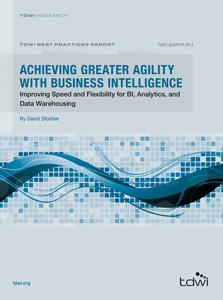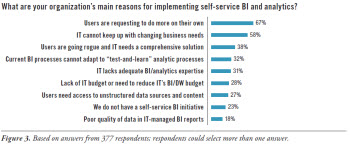 View online: tdwi.org/flashpoint
View online: tdwi.org/flashpoint





June 6, 2013
ANNOUNCEMENTS
Submissions for the next Business Intelligence Journal are due August 8.
View submission guidelines
CONTENTS

TDWI Salary Survey: Average Wages Rise a Modest 2.3 Percent in 2012

Is “In-Memory” Always the Right Choice?

Managed Self-Service BI and Analytics for Agility

Mistake: Lack of Data Governance

See what's
current in TDWI Education, Events, Webinars,
and Marketplace

TDWI Salary Survey: Average Wages Rise a Modest 2.3 Percent in 2012
Mark Hammond
TDWI Contributing Analyst
Topics:
Program Management
Wondering how your wages, bonuses, job satisfaction, and responsibilities compare to your peers? TDWI breaks it down in the 2013 TDWI Salary, Roles, and Responsibilities Report.
Average salaries for full-time permanent BI/DW employees rose a modest, if unspectacular, 2.3 percent in 2012, to a record high of $106,818. These findings, from TDWI’s survey of 885 BI/DW professionals in the U.S. and Canada in fall 2012, are in line with the IT industry at large, with both InformationWeek and Computerworld reporting similar increases in their most recent salary surveys.
At the same time, average wages for BI/DW freelancers and contractors (4 percent of our respondent pool) suffered a precipitous 16 percent decline, shrinking to about $121,000. The median wage across both permanent employees and contractors was up 2.9 percent in 2012, to $105,000.
Average bonuses, meanwhile, dipped 13 percent to $14,252, though that decrease comes after a stunning 51 percent gain in 2011. Compared to 2010, bonuses in 2012 were up a healthy 31 percent, and nearly two-thirds of BI/DW professionals received some type of bonus, the same as 2011.
Available exclusively to TDWI Premium Members, the 2013 TDWI Salary, Roles, and Responsibilities Report provides a valuable guide for both employees and managers to assess compensation and bonuses by key roles, from the highest paid (BI directors at an average salary of $136,187 in 2012) to the lowest (business requirements analysts at $86,786).
The report slices and dices compensation data by a number of dimensions, such as gender, organizational BI maturity, organizational revenues, years of experience, certifications, and industry. It also examines job satisfaction, top considerations for a new job, and respondents’ sense of job security and fair compensation. Highlights include:
Gender. Women continue to lag far behind men in average salary ($97,037 versus $111,225, a $14,188 gap) and bonuses ($9,566 versus $15,770). Moreover, fewer women than men received bonuses (61 percent versus 67 percent).
BI maturity. Organizations with “advanced” BI environments pay roughly $15,000 more in salary than “beginner” BI organizations--$113,921 versus $98,804--as they tend to invest in seasoned, multi-skilled BI/DW professionals with a proven track record of driving business value from BI.
Company size. The largest organizations (those with more than $50 billion in revenue) offer the largest salaries--$120,820 on average, or nearly $22,000 more than organizations with revenues between $500 million and $1 billion.
Region. Geographic location is a large factor in compensation. BI/DW professionals in the Mid-Atlantic states command an average salary of $135,568, or about $43,000 more than those in the Central Plains ($92,446). Canadians earn less still, with an $88,251 average.
Certifications. IT-related certifications such as TDWI’s Certified Business Intelligence Professional (CBIP) are a surefire way to increase earning power. BI/DW professionals holding a TDWI CBIP certification command an average salary of $113,501--$8,200 greater than the average for non-certified professionals.
Job and compensation satisfaction. Forty-nine percent of respondents ranked their job satisfaction as “high” or “very high,” up notably from a record low of 42 percent during the depths of the 2010 recession. Similarly, 48 percent believe they are fairly compensated.
Secondary roles. BI/DW professionals are gradually taking on a greater number of secondary roles. The average of 3.52 secondary roles is the highest in this survey series, dating to 2003. This reflects an organizational focus on cost-effectiveness through multi-skilled individuals, as well as employee appetite for a challenge--“challenging work” and “chance to develop new skills” were among the top considerations for a new job.
The salary report also takes an in-depth look at 10 key roles, with breakdowns by salaries and bonuses, average age, years of experience, certifications, professional background, and more. If you are a TDWI Premium Member, you can download a copy of the 2013 TDWI Salary, Roles, and Responsibilities Report now.
Mark Hammond is a veteran contributor to TDWI, including a number of research reports, Business Intelligence Journal, and What Works.

Is “In-Memory” Always the Right Choice?
Katrina Read
Selective use of “in-memory” technology is key to finding the right balance between managing exponential data growth and supporting in-time business decisions.
Data volumes are growing exponentially. Whether you’re trying to make sense of the 12 terabytes of tweets created each day to better understand campaign effectiveness or collecting 350 billion annual meter readings to better forecast power consumption, there is no question that the amount of data available to us is increasing at a rate faster than our ability to consume and derive insight.
At the same time, business users are demanding instantaneous answers to their analytical questions. Organizations are encouraging decision makers to substantiate their intuition with fact- and data-driven insight--a futile effort if information is not available as needed to make key decisions. Although executives want to support fact-based decision making, they know they can’t do it with complex, hard-to-use tools that require extensive IT handholding. For time-sensitive processes such as responding to a customer who has contacted the call center, data must be accessed and analyzed within minutes to be able to take the right action. The traditional approach of storing information in a data warehouse for retrospective analysis simply won’t cut it.
Faced with these opposing forces, it’s easy to fall into the trap of thinking that “in memory” is the answer to everything. Promising faster query response times and insight at the speed of thought, many vendors tout in-memory analytics as the silver bullet to performance issues often associated with traditional data warehouses. Coupled with the recent decline in the cost of memory, there has been a renewed interest from enterprises of all sizes as they strategize how in-memory will feature in their business intelligence road maps.
Read the full article and more: Download Business Intelligence Journal, Vol. 18, No. 1



Highlight of key findings from TDWI's wide variety of research
Managed Self-Service BI and Analytics for Agility
The “self-service” or self-directed wave in BI, analytics, and data discovery technology is strong; more than half of TDWI Research respondents said that increasing users’ self-reliance with BI and analytics and reducing their dependence on IT are very important goals, with one-third indicating that these are somewhat important. The percentages are similar when filtered for either IT or non-IT titles, suggesting that meeting self-service objectives is a priority on both business and IT sides.
Respondents indicated that users’ requesting to do more on their own (67%) is the most common reason why organizations are implementing self-service BI and analytics (see Figure 3). The second most prominent reason helps reveal why they want to do more on their own: 58% said that self-service functionality is important because “IT cannot keep up with changing business needs.” Users are frustrated with the IT backlog and with having to wait for new applications and features to be deployed even as strategic business needs grow more urgent. In addition, 31% of respondents selected “IT lacks adequate BI/analytics expertise,” a factor that could be contributing to the backlog problem and suggests that within some organizations there is a lack of confidence in IT’s BI and analytics capabilities.
Read the full report: Download Achieving Greater Agility with Business Intelligence



FlashPoint Rx prescribes a "Mistake to Avoid" for business intelligence and data warehousing professionals.
Mistake: Lack of Data Governance
Krish Krishnan
Data governance is the lynchpin for the success of enterprise data integration and management of data across its life cycle. Big data is no exception when it comes to data governance; it needs to be treated as another data set within the enterprise that requires stewardship and associated processes for managing the data to be designed, developed, and deployed.
Fundamentally, the processes associated with the governance of traditional data--stewardship, program governance, business rules, data quality, and master data management--can be extended to big data, with additional focus on metadata, business rules, and semantic library integration. The challenges in governing big data include the complexity associated with the processing of data, the business rules definition for processing the data, and the multi-owner-based stewardship of the data, where conflicting requirements will be the norm. We have already mentioned several areas of big data governance; one additional point is to remember that big data integration projects will need sponsorship and executive guidance.
Without the right type of data governance, your program will not only fail but may also damage the existing analytical programs that have been deployed by skewing results and decreasing user confidence about the value of integrating big data.
Read the full issue: Download Ten Mistakes to Avoid In Your Big Data Implementation (Q1 2013)




